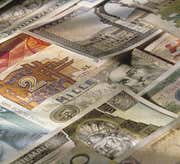|

|
Investors new to equities can be tempted to sell short certain stocks because they have a relatively high P/E ratio. If you aren't familiar with short selling, it's an investing technique by which an investor can make money when the price of a stock falls in value. (For more on this, check out the Short Selling tutorial.)
First of all, we believe that novice investors should be exceedingly wary of short selling. Second, you can get into a lot of trouble by valuing stocks by only using simple indicators such as the P/E ratio. Although a high P/E ratio could mean that a stock is overvalued, there is no guarantee that it will come back down anytime soon. On the flip side, even if a stock is undervalued, it could take years for the market to value it in the proper way.
At the same time, a company with a low P/E may never rise because it has lost its growth prospects. Earlier in this tutorial, we related the case of Microsoft (MSFT), whose shares traded at a P/E of over 100 several years ago, but only has a P/E of 30 now. This does not imply that Microsoft is now undervalued, since it has reached a point in its corporate life cycle that makes it a more stable, low-growth company. Likewise, Amazon.com Inc. (AMZN) still has a very high P/E of 170, but the market may believe that the company, even though it’s been around for a long time now, still has terrific growth prospects.
Security analysis requires a great deal more than understanding a few ratios. While the P/E is one part of the puzzle, it's definitely not a crystal ball. Still, some investment styles are broadly based on P/E measures. For example, growth investing tends to favor stocks with high P/E ratios that are justified by future growth prospects, while value investing looks to stocks with low P/E ratios that will provide steady and stable returns.
P/E Ratio: Conclusion
-
 Investing
InvestingIs Stock With a Lower P/E Always A Better Choice?
Is a stock with a lower P/E always a better investment than a stock with a higher one? The short answer is no, but it depends on a few things. -
 Investing
InvestingCan Investors Trust The P/E Ratio?
The P/E ratio is one of the most popular stock market ratios, but it has some serious flaws that investors should know about. -
 Trading
TradingValue-Priced Stocks to Watch in 2016 (AMBC, VIPS)
In terms of P/E and Forward P/E these stocks are trading at low valuations. Watch these technical price levels for buying opportunities in 2016. -
 Investing
InvestingUnderstanding The P/E Ratio
Learn what the price/earnings ratio really means and how you should use it to value companies. -
 Investing
InvestingWhat Lies Ahead for Apple's P/E ratio
Recently, Apple's P/E multiple has come down to levels equal to the S&P 500. What does the future hold for the tech giant's P/E ratio? -
 Investing
InvestingHow Do I Calculate the Price-Earnings Ratio?
If Apple is trading at $108.73 per share, and its trailing twelve months' EPS is $6.45, calculate the P/E ratio as...


